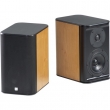Snell Acoustics J7 Bookshelf speakers
Snell J7 cases are hand-made and differ with impeccable anti-resonant characteristics. The upper part and the lower base are made of metal, and the side walls are made of solid wood. The crossover is characterized by minimal deviations (tolerance of 0.5 dB) and has a selector to attenuate returns at low frequencies. Drivers are from SEAS. A 165-mm midwoofer is with a pulp diffuser, hardened with a special coating, and a 27-mm tweeter is with a silk dome.
Snell J7 have a good musical balance, but linearity is not the most outstanding quality of these systems. The width of the frequency and dynamic ranges is surprising. In terms of bass depth, these shelf speakers can compete with much larger floor systems and, in playback quality, even surpass them. In the lower case there is no hint of heaviness and laziness. I don't remember other monitors that are capable of giving the same dashing "punch" that Snell J7 has. In the middle range, the lower voice formants are reproduced a little weakened, making vocals sound a little lighter. On jazz and rock music, this feature is noticeable. But for chamber, choral or symphonic music this is what you need - J7 give out a lot of important musical information and play with a pleasant emotional intensity.
Judging strictly, reproduction in the upper range cannot also be admitted the ideal of linearity. However, tweeters do not "tie" the sound and are highly detailed. And the spatial qualities of Snell J7 should generally be recognized as the most spectacular in our test. Not only sources on front, middle or remote plan of the scene are localized, but also on the side, on the listening line, behind and even next to the listener (unless, of course, such sources exist in the phonogram). This feature is interesting and quite valuable.




